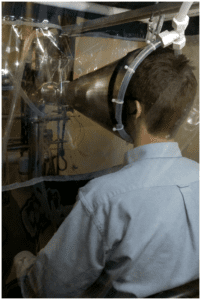

Volunteers in a college community were screened for influenza virus infection, and 156 were selected for study of exhaled breath using a Gesundheit-II bio aerosol sampler (pictured – image credit). Participants were seated before a cone-shaped inlet which draws in 130 liters of air per minute while the participants breathe, talk, cough, and sneeze. As talking produces fine aerosols, participants were asked to recite the alphabet three times. Coarse aerosols produced by sneezing and coughing were also collected, as were nasopharyngeal swabs. These samples, together with breathing aerosols, were examined for the presence of influenza virus RNA by polymerase chain reaction. All except coarse aerosol samples were also examined for the presence of infectious virus. Here are some of the key findings:
- Infectious influenza virus was found in 39% of fine aerosol samples – these are produced by normal tidal breathing. This finding shows that individuals infected with influenza virus routinely shed infectious virus in their breath. Fine aerosols produced by breathing are probably the main airborne transmission mechanism.
- Participants rarely sneezed and this activity does not appear to substantially contribute to influenza virus aerosol shedding.
- Cough was frequent; it was a predictor of virus shedding into coarse and fine aerosols, but was not needed for presence of infectious virus in the fine aerosols. Cough is probably a response to irritation, but not a main source of infectious aerosols.
- Airways of the head do not make a significant contribution to the generation of aerosols; these are mainly produced in the lung.
- Infection in the upper and lower airway is compartmentalized and independent.
That normal tidal breathing is the main source of fine aerosols – which can remain suspended in the air to reach others – is consistent with the difficulty in preventing transmission of this infection. Unfortunately, peak exhaled viral titers occur before onset of symptoms, emphasizing the value of preventing infection by vaccination.
Speaking of vaccination – fine aerosol RNA shedding was higher in participants who had been immunized in the current and previous years. It is thought that lung inflammation increases the generation of aerosols and therefore the contagiousness of the host. It is possible that an immunized individual experiences increased lung inflammation, explaining this observation.
It is not clear if the effect of vaccination on shedding of influenza virus is a meaningful result. This difference was only observed for influenza A, and not influenza B infections. Furthermore, self-reporting vaccination status might have introduced error – it would be more accurate to correlate the immune status of participants with shedding in fine aerosols. Nevertheless, the observation warrants further study.

Pingback: A breath of fresh influenza virus - VETMEDICS
Pingback: A breath of fresh influenza virus - Virology
Pingback: A breath of fresh influenza virus - Vetmedics